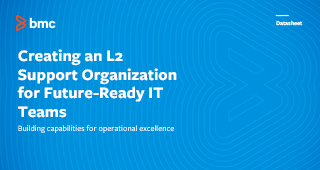This is part 3 of a 3-part series exploring the implementation, refinement, and operation of an L2 service organization at BMC, and how you might find a similar path useful at your organization.
In part 1 and part 2 of this series, we discussed service levels in general, how service levels function at IT, and why we decided to pursue an L2 organization overhaul at BMC, as well as some of the benefits we realized. In this final installment, we will talk in more detail about our actual process and outcomes, as well as lessons we learned along the way.
For any IT organization, the desire to transcend from cost center to value provider is understandable. Digital disruption continues to create escalating customer demands, both internal and external, and IT must rise to the challenge without simultaneously driving up costs.
We knew that our success hinged on two criteria: people and processes. The resulting transformation evolved with those factors as determinants in every step.
- Staffing strategy—Creating the right talent pool wasn’t just about onboarding; it was about building a team of motivated people who were excited about new technology. Over a fiscal year, we cultivated a mix of interns (engineering graduates at the L1/L2 level) and experienced professionals, both of which could be converted to FT employees based on performance. Our existing internal talent were tapped for desired skills and abilities (speed and reliability were crucial), and their institutional knowledge helped bolster the resulting team: enthusiastic, enabled, and aligned to our vision.
- Transition strategy—a critical component of the L2 process was defining the organization’s scope of services. In our case, we designed with a focus around corrective, preventive, perfective, and adaptive activities. These included:
- Creating and updating existing knowledge repositories
- Ensuring that regular maintenance schedules were created and maintained for knowledge articles on various platforms
- Enabling profile-specific application and instance access for efficient support delivery
- Assisted support—we implemented a period of shadow support between service levels to ensure processes were set up correctly, that monitoring was in place, that the ticketing system was ready to accommodate the increased volume of requests, and that a proper reporting cadence had been established.
- Go live—Once our checklist had been met, RACI playbooks and other tools were engrained, and a steady state was established, we were ready for launch.
Optimization in Action
With the L2 support organization live, workload optimization was our goal, knowing that every hour saved by L2 contributed to the efficiency of L3… and to our continued innovation capabilities. By segregating roles within operations and engineering, training needs became evident, and we were able to maximize retraining efforts and resources as well.
We also continued efforts across our career progression path with the mantra, “Move work down and move people up.” Essentially, this means that as we were able to push work to lower levels (even to L0—automation or retirement), we repurposed our employees enabling them to move up the ladder and into more challenging roles. , With these optimization efforts in place, we were also able to listen more closely to internal customers and identify opportunities for automation and innovation with new technology. Most importantly, proven performers are recognized across the org for L2 and L3 positions, and senior performers become the next generation of IT leaders.
Besides saving an incredible number of work hours for L3, the L2 model has exposed the teams to collaboration opportunities within IT and with other business units, offering them an overarching view of operational functions and allowing them to become the VOC (voice of the customer). With that connection, necessary improvements are noted early and can be responded to more efficiently—and identified needs can be translated into technology initiatives and innovations.
This emphasis on innovation and “going lean” has reached across every aspect of our organization and includes the use of automation and AI to do away with manual, repetitive tasks. With identified patterns and trends from service requests, we were able to implement chatbots to replace L1 calls in many cases, empowering users to help themselves and further proving IT as a value driver.
Finally, as part of our sales partnership, we have been able to take the role of Customer Zero with these new technologies, sharing our product experience and live demos with sales prospects. This benchmark has not only reinforced existing customer trust—it has also won new business for the company.
Cultural Accommodations
As anyone who has undertaken a large organizational change can attest, feelings around job security, career growth, and knowledge opportunities must be managed carefully. Conflict and chaos can arise when results aren’t in line with expectations, and we focused on diligent strategies to keep morale and productivity high. These include:
- Friday learnings—open houses to discuss doubts, opportunities, and prospects, along with achievement recognition
- Dedicated learnings—regular in-house training to foster continuous learning, and education assistance for employees to build their skills
- Growth prospects—efforts to ensure employees can pursue opportunities at the company outside their current responsibilities
- Employee advocate—employees partner to ensure teamwork and a culture of passion and learning
Some final thoughts: creating the dedicated L2 team at BMC made it clear that a focus on building capabilities (and keeping employees satisfied) is critical to success. In our three-year experience, we have also gained constructive customer insights that have led to successful implementation of several cognitive tools, and have further cemented existing customer relationships while gaining new prospects. DevOps provides additional opportunities for skill enhancement and team building.
If you have followed this entire blog series—thank you. Your interest in pursuing a profound shift in the way IT can provide service is important, and we hope that some of what we have shared here will be helpful to you in your journey.
To learn more about creating an effective L2 organization at your company, including our benchmarks and outcomes, please read the white paper about BMC’s journey.
Creating an L2 Organization for Future-Ready IT Teams
These postings are my own and do not necessarily represent BMC's position, strategies, or opinion.
See an error or have a suggestion? Please let us know by emailing blogs@bmc.com.







